The Pound Sterling (GBP) initially gained against the US Dollar (USD) but later surrendered its gains following upbeat US economic data. Retail Sales in the US grew by 1% in July, exceeding estimates of 0.3%, while jobless claims fell to 227K, lower than estimates of 235K. These positive economic indicators led to a strong recovery in the US Dollar, with the US Dollar Index (DXY) rising more than 0.6% to 103.20. Despite the optimistic data, expectations for Federal Reserve (Fed) interest-rate cuts in September remain firm.
The UK Office for National Statistics (ONS) reported that the UK economy grew by 0.6% in the second quarter of the year, in line with expectations. This growth rate was slightly lower than the previous quarter but still robust. The UK economy flatlined in June, as anticipated. Lower price pressures and decent growth rates provide relief for Bank of England (BoE) policymakers, who are considering a rate cut to alleviate the burden on households and the economy. The UK’s inflation rate decreased in July, prompting expectations for a BoE rate cut in September.
The Pound Sterling outperformed most major currencies in Thursday’s trading session, with the exception of the Australian Dollar. The flash Gross Domestic Product (GDP) report showed a quarterly growth rate of 0.6% and an annual growth rate of 0.9%, slower than the previous quarter but still solid. Industrial and Manufacturing Production in June also showed positive growth figures, surpassing market expectations. These economic indicators contribute to the overall positive performance of the Pound Sterling in the foreign exchange market.
In terms of technical analysis, the Pound Sterling remains supported near the 1.2800 level against the US Dollar, following a failed attempt to break the two-week high of 1.2870. The currency pair struggles to hold the 20-day Exponential Moving Average (EMA) around 1.2800. The recovery from a six-week low of 1.2665 was supported by a positive divergence formation on the daily time frame, indicating a potential uptrend. The Relative Strength Index (RSI) shows signs of buying interest at lower levels, with major resistance levels at 1.2900 and 1.3000.
Overall, the Pound Sterling’s performance in the foreign exchange market is influenced by both UK and US economic data releases. While the GBP initially gained against the USD, it later surrendered its gains following strong US retail sales and lower jobless claims. On the other hand, positive UK GDP numbers and lower inflation rates support the Pound Sterling’s resilience. Technical analysis suggests that the currency pair is supported near 1.2800, with key resistance levels at 1.2900 and 1.3000. Market participants will continue to monitor economic data releases and central bank policies for further insights into the Pound Sterling’s performance.









